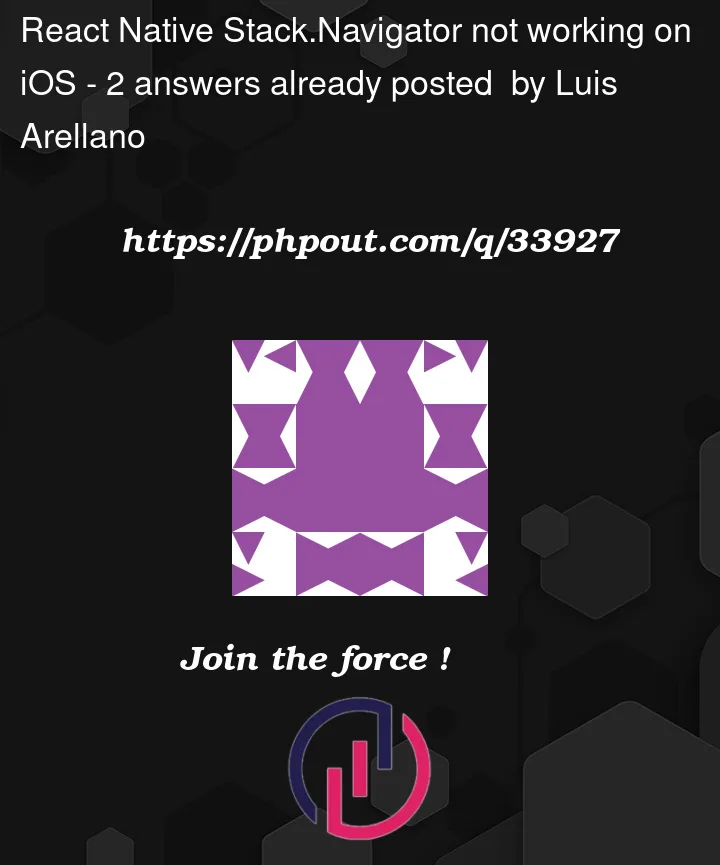Sorry if this is basic, but I’m trying to create my first react-native app and I’m a bit confused about react-navigation and the npm dependencies.
I’m using Expo to build my project, and it deploys correctly on web, but when I try o connect using my iphone, I don’t see anything within the Stack.Navigator component.
I suspect it has to do with the npm packages. Perhaps some don’t work on ios? Also I don’t get any error code so I’m not sure how to debug. Any clues?
For context, here is my code
App.js
import { StatusBar } from "expo-status-bar";
import { useEffect, useState } from "react";
import * as Font from "expo-font";
import { StyleSheet, Text, SafeAreaView } from "react-native";
import { initializeApp } from "firebase/app";
import * as SplashScreen from "expo-splash-screen";
import { credentials } from "./src/utils/firebase";
import MyStack from "./src/screens/stack/navigation";
import AppStack from "./src/screens/stack/appstack";
// Keep the splash screen visible while we fetch resources
SplashScreen.preventAutoHideAsync();
export default function App() {
const [dataLoaded, setDataLoaded] = useState(false);
useEffect(() => {
async function prepare() {
try {
await initializeApp(credentials);
await SplashScreen.preventAutoHideAsync();
await fetchFonts();
} catch (e) {
console.warn(e);
} finally {
setDataLoaded(true);
}
}
prepare();
}, []);
if (!dataLoaded) {
return null;
}
return (
<SafeAreaView style={styles.container}>
<Text>SHAKA!</Text>
<AppStack />
<StatusBar style="auto" />
</SafeAreaView>
);
}
const fetchFonts = () => {
return Font.loadAsync({
"PlusJakartaSans-Regular": require("./assets/fonts/PlusJakartaSans-Regular.ttf"),
"PlusJakartaSans-Medium": require("./assets/fonts/PlusJakartaSans-Medium.ttf"),
"PlusJakartaSans-Bold": require("./assets/fonts/PlusJakartaSans-Bold.ttf"),
"Poppins-Regular": require("./assets/fonts/Poppins-Regular.ttf"),
"Poppins-Medium": require("./assets/fonts/Poppins-Medium.ttf"),
"Poppins-Bold": require("./assets/fonts/Poppins-Bold.ttf"),
"Poppins-SemiBold": require("./assets/fonts/Poppins-SemiBold.ttf"),
});
};
const styles = StyleSheet.create({
container: {
flex: 1,
backgroundColor: "#fff",
alignItems: "center",
justifyContent: "center",
},
});
appstack.js
mport React from "react";
import { Provider } from "react-redux";
import { createStore } from "react-redux";
import ContextWrapper from "../../context/context";
import { NavigationContainer } from "@react-navigation/native";
import { createNativeStackNavigator } from "@react-navigation/native-stack";
import { StyleSheet, Button, Text, SafeAreaView } from "react-native";
import { StatusBar } from "expo-status-bar";
import Home from "../Home";
const Stack = createNativeStackNavigator();
const HomeScreen = ({ navigation }) => {
return (
<SafeAreaView style={styles.container}>
<Text>Home jjkdjfk</Text>
<Button title="Next Screen" />
<StatusBar style="auto" />
</SafeAreaView>
);
};
export default function AppStack() {
return (
<ContextWrapper>
<NavigationContainer>
<Stack.Navigator>
<Stack.Screen
name="HomeScreen"
component={HomeScreen}
options={{ title: "button" }}
/>
<Stack.Screen
name="Home"
component={Home}
options={{ title: "Home" }}
/>
</Stack.Navigator>
</NavigationContainer>
</ContextWrapper>
);
}
const styles = StyleSheet.create({
container: {
flex: 1,
backgroundColor: "#fff",
alignItems: "center",
justifyContent: "center",
},
});
package.json
{
"name": "shaka",
"version": "1.0.0",
"main": "node_modules/expo/AppEntry.js",
"scripts": {
"start": "expo start",
"android": "expo start --android",
"ios": "expo start --ios",
"web": "expo start --web"
},
"dependencies": {
"@expo/webpack-config": "^0.17.0",
"@react-navigation/native": "^6.0.10",
"@react-navigation/native-stack": "^6.6.2",
"@react-navigation/stack": "^6.3.4",
"expo": "~45.0.0",
"expo-splash-screen": "~0.15.1",
"expo-status-bar": "~1.3.0",
"firebase": "^9.12.1",
"react": "17.0.2",
"react-dom": "17.0.2",
"react-native": "0.68.2",
"react-native-safe-area-context": "^4.4.1",
"react-native-screens": "^3.11.2",
"react-native-web": "~0.18.7",
"react-redux": "^8.0.4"
},
"devDependencies": {
"@babel/core": "^7.12.9"
},
"private": true
}




2
Answers
Ok figured out the issue.
You are calling
SplashScreen.preventAutoHideAsync()twice in your code. I guess the second call should behideAsync().Check expo splash screen docs for more details.